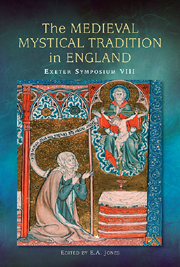 The Medieval Mystical Tradition in England
The Medieval Mystical Tradition in England Published online by Cambridge University Press: 05 July 2013
THE SYMPOSIUM also received brief reports on some work in progress. Barbara Zimbalist (University of California Davis) is developing an argument that, through the representation of Christ's apocryphal speech in the vernacular, women's visionary texts reflect a growing desire for access to the Word of God among lay readers. Through the development of Christ's voice as a mode of devotional discourse, women's visionary texts make a distinct contribution to the increasingly varied modes of vernacular devotion, and offer readers opportunity for textual processes of imitatio Christi founded on Christ's identity as speaker and evangelist - an alternative to the more widely acknowledged tradition of passion-based, corporeally realised modes of affective piety offen attributed to women. By reading the long tradition of Christ's extra-biblical speech as texts that evoked specific interpretative hermeneutics, she is arguing for a more nuanced understanding of vernacular devotion within late-medieval literacy and a more inclusive view of the varied textual traditions - including women's visionary texts - that contributed to the changing literary landscape of vernacular devotional in the later Middle Ages.
Laura Kalas Williams (University of Exeter) is working on a project examining conceptualisations of pain in the writings of Bridget of Sweden and Margery Kempe and their relationship with paradigms of physiology and illness in medieval medical writing. Noting that the internal, esoteric and ineffable qualities of both physical pain and visionary experience mark an ontological correlation that has received surprisingly little scholarly attention, Williams is conducting the first detailed examination of maternalised pain in these texts, with a particular consideration of the perception of surrogate or adoptive pain.
To save this book to your Kindle, first ensure [email protected] is added to your Approved Personal Document E-mail List under your Personal Document Settings on the Manage Your Content and Devices page of your Amazon account. Then enter the ‘name’ part of your Kindle email address below. Find out more about saving to your Kindle.
Note you can select to save to either the @free.kindle.com or @kindle.com variations. ‘@free.kindle.com’ emails are free but can only be saved to your device when it is connected to wi-fi. ‘@kindle.com’ emails can be delivered even when you are not connected to wi-fi, but note that service fees apply.
Find out more about the Kindle Personal Document Service.
To save content items to your account, please confirm that you agree to abide by our usage policies. If this is the first time you use this feature, you will be asked to authorise Cambridge Core to connect with your account. Find out more about saving content to Dropbox.
To save content items to your account, please confirm that you agree to abide by our usage policies. If this is the first time you use this feature, you will be asked to authorise Cambridge Core to connect with your account. Find out more about saving content to Google Drive.